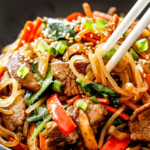Korean Spicy Noodles
Korean Spicy Noodles are a glass noodle stir fry loaded with tender beef, mushrooms, carrots, onions and bell peppers all bathed in a spicy soy, ginger, garlic sesame sauce. It is a symphony of tantalizing flavors and textures and one of my favorite recipes to date – you don’t want to miss this one! Most of the work for these Korean Spicy Noodles is is slicing your steak/veggies beforehand, so when its “go” time you can have dinner on the table in less than 15 minutes.
|
Ingredients
Stir Fry
Marinade/Sauce
Add later:
Garnish
|
Instructions
|
Recipe Notes
Where Can I Buy Korean Noodles?
- You can buy Korean Noodles on Amazon or in any Asian specialty store but take care you are purchasing the correct glass noodles.
- I purchased my Korean Noodles on Amazon and they were called, “Glass Noodles, Korean Vermicelli, Dangmyun, Sweet Potato Starch.”
- Glass noodles come in a few different varieties. Non-Korean glass noodles are often made with mung bean starch or green pea starch. They can also have different shapes from thin noodles to wide, flat noodles resembling brownish, clear fettuccine. We are looking for the thicker, round grey Korean noodles made from sweet potato starch. If you aren’t sure if the noodles are correct, check the ingredient list for sweet potato starch.
TIPS AND TRICKS
- Gochuchang. Gochuchang is a Korean BBQ Sauce that’s the perfect blend of savory, sweet and spicy. I use Annie Chun’s Sweet and Spicy Gochujang Sauce located in the Asian section of my grocery store, but you can also easily buy it on Amazon.
- Rice Wine. Rice wine is NOT rice vinegar- DO NOT switch them out. I use “Kikkoman Aji-Mirin: Sweet Cooking Rice Seasoning” which is commonly found in the Asian section of most grocery stores or you can Amazon it. I highly suggest you google image before you head off to the grocery store so you know exactly what you are looking for. The best substitute for rice wine is pale dry sherry.
- Freeze beef. The easiest way to thinly slice beef is while it is partially frozen. Wrap beef in plastic wrap or place in a freezer bag and freeze 1-2 hours until it is firm enough to hold shape but still soft enough to slice. I like to cut the beef in half and place one half in the freezer until I am finished slicing the first half so it doesn’t start to defrost on the cutting board.
- Cut beef across the grain. You can see the “grain” running through the meat in one direction. The grain is essentially the muscle fibers running through the meat. You want to cut perpendicular to the muscle fibers so they become as short as possible as opposed to long muscle fibers. Long muscle fibers will give you chewy, rubbery tough meat – so cut AGAINST the grain.
- Use a hot skillet. Your pan should be hot enough so that the meat sizzles as soon as it touches the pan. We want the outside of our meat to develop a nice sear while the inside remains tender, this ensures juicy steak.
- Don’t overcrowd your pan. Cook your steak in 2 batches so you don’t overcrowd your skillet which will steam instead of sear your beef.
- Mushrooms. Purchase fresh shiitake mushrooms. If you purchase dried mushrooms you will have to soak them in water before using them. You may also substitute another variety of mushroom.
- Carrots. If you don’t cut your own matchstick carrots, then store-bought matchstick carrots will be much thinner. Add store-bought matchstick carrots to the skillet with the bell peppers and NOT the onions/mushrooms.
- Customize. Feel to customize the veggie and use your favorites.
- Heat. Start with less than 2 tablespoons Gochuchang if you know you don’t like much heat. Add more Gochuchang to taste at the end for spicier Korean Spicy Noodles.

No comments:
Post a Comment